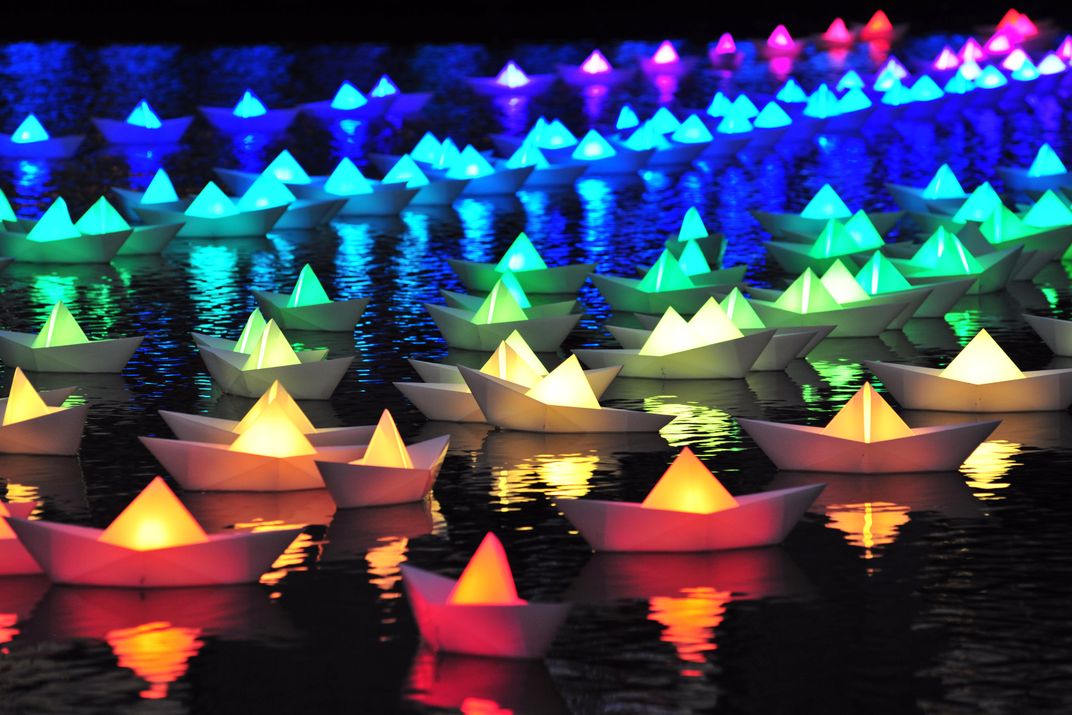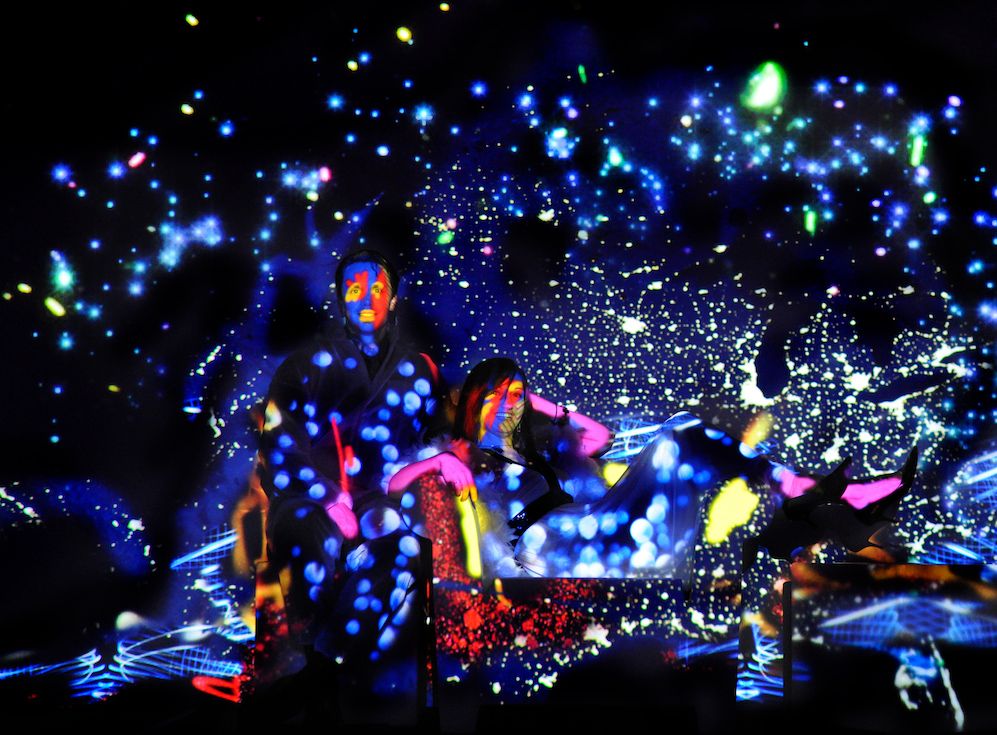See Dozens of Dazzling New Light Installations in Baltimore This Week
Light City Baltimore is a massive, site-specific festival, launched in hopes of becoming an annual spectacle
The first city in the United States to get gas lamps wasn’t Boston, New York City or even Philadelphia. No, it was Baltimore. In 1816, Rembrandt Peale, owner of the Baltimore Museum (now called The Peale Center) and founder of the Gas Light Company of Baltimore, demonstrated the new technology in what he called a “magic ring” of carbureted hydrogen gas. He was eager to find a new way to spotlight the museum's artwork while protecting it from the soot and smoke that came with burning oil lamps and candles. Soon, the entire city was aglow.
Now, 200 years later, Baltimore will mark another milestone in its history as a lighting pioneer by hosting the United States' first large-scale, international light festival. Called Light City Baltimore, the free event, which runs from March 28 through April 3, merges massive, site-specific light installations with musical and theatrical performances around the city’s harbor. All told, the week-long festival will include 50 attractions spanning a one-and-a-half-mile artwalk along the waterfront. In addition to the installations and performances, the festival will also include a variety of innovative conferences as part of Light City U, including events focused on health and sustainability. Other notable attractions include an LED-lit Ferris wheel, dance performances, talks and a youth festival.
In a nod to the city, the Baltimore Office of Promotion and the Arts chose Baltimore-based artists to create almost all of the installations. Their pieces will be seen for the first time ever during Light City. Examples include an interactive piece called “Blue Hour” by New American Public Art comprised of 10 glowing light towers and “Light Wave: Baltimore’s Beacon” by Design Collective, which translates sounds into light waves and bounces them off of Pier 5's Seven Foot Knoll Lighthouse.
Another local artist whose work will light up the event is Paul Rucker, who’s also a musician and composer. For his piece “In Light of History,” he focuses on the city’s brutal past as a critical hub in the trans-America slave trade. Rucker pinpointed the exact locations of about a dozen slave auctions around the harbor and will highlight these spots through original light compositions and cello music.
“Pratt Street was one area of town that was particularly popular with slave dealers,” Rucker says. “Because Baltimore wasn’t part of the [Confederacy], it didn’t fall under the Emancipation Proclamation, so dealers would often post ads around town advertising the slave auctions [as late as 1864].”
His installation is particularly poignant considering the riots that broke out last year after the death of Freddie Gray. “A lot of the issues we see in the city today can be connected back to slavery,” he says.
“Our city has experienced many challenges in recent months,” says Kathy Hornig, festival director at the Baltimore Office of Promotion and the Arts. “We’re hoping that Light City will literally and figuratively shine a positive light on Baltimore and all of the amazing innovators and artists who are living and working here every day.”
The event, which is being compared to Austin’s South by Southwest and Miami’s Art Basel, offers a shining beacon for a city that underwent a tumultuous few months after the death of Freddie Gray and the civil unrest that followed last April. While the Light City festival likely won't ease the racial tensions and divides that persist in the deeply segregated city, if all goes as planned, the organizers could become an annual event that can help Baltimore recapture Rembrandt Peale's magic glow.
/https://tf-cmsv2-smithsonianmag-media.s3.amazonaws.com/filer/fe/2e/fe2eeed5-89f5-4f97-8d43-3ef3a23ef225/image_credit_blue_hour_by_new_american_public_art.jpg)
/https://tf-cmsv2-smithsonianmag-media.s3.amazonaws.com/filer/32/bf/32bfa219-39ed-4921-a230-8f5c1c510e6f/image_credit_diamonds_light_baltimore_by_mina_cheon_and_gabriel_kroiz.jpg)
/https://tf-cmsv2-smithsonianmag-media.s3.amazonaws.com/filer/05/f5/05f5b80f-a649-4172-9d04-2cc7625677ab/image_credit_glacier_by_riki_k.jpg)
/https://tf-cmsv2-smithsonianmag-media.s3.amazonaws.com/filer/8d/a9/8da980c7-3e01-4caf-99ad-7797b2ef0e11/image_credit_laser_lotus_by_natasha_ramnath.jpg)
/https://tf-cmsv2-smithsonianmag-media.s3.amazonaws.com/filer/71/87/7187b98a-3d35-418e-a538-73ebad2578f9/image_credit_lightwave_baltimores_beacon_by_design_collective_inc.jpg)
/https://tf-cmsv2-smithsonianmag-media.s3.amazonaws.com/filer/f6/2c/f62cd8af-987e-46c2-8bca-5270a833408d/image_credit_natural_lighting_emulator_v_by_lisa_dillin.jpg)
/https://tf-cmsv2-smithsonianmag-media.s3.amazonaws.com/filer/27/47/27474667-900a-44c6-b6c8-8ad4b91c05e6/image_credit_projected_aquaculture_by_kelley_bell_and_corrie_parks.jpg)
/https://tf-cmsv2-smithsonianmag-media.s3.amazonaws.com/filer/8a/fb/8afb3311-9cf7-4116-a2e9-950a5ec2f022/image_credit_the_pool_by_jen_lewin_photo_by_denise_leong.jpg)

/https://tf-cmsv2-smithsonianmag-media.s3.amazonaws.com/filer/70/d0/70d0a09a-a7ec-4a56-93ee-d91715453d51/image_credit_water_will_be_here_by_eric_corriel.jpg)


